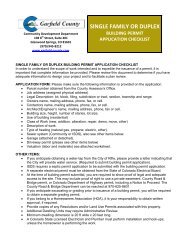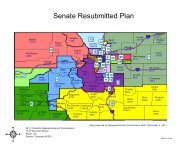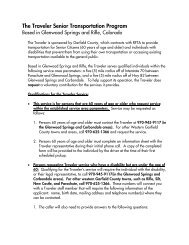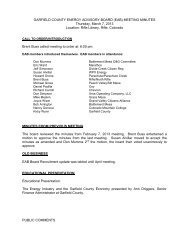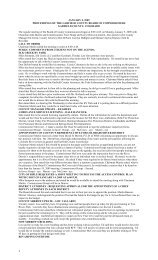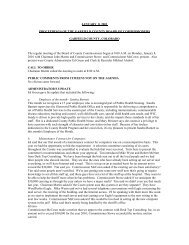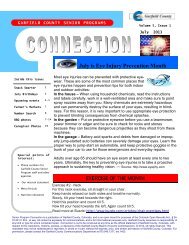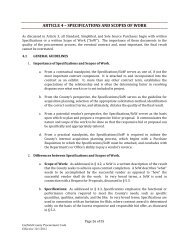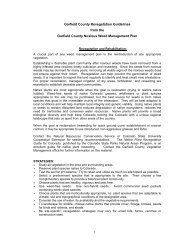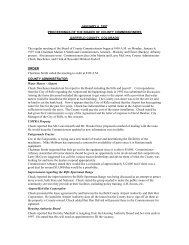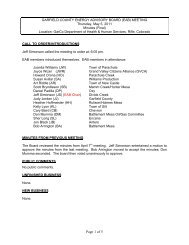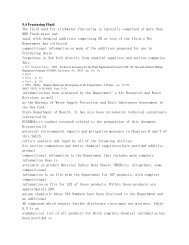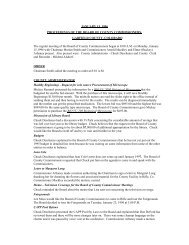Appendix D: Human Health Risk Assessment - Garfield County ...
Appendix D: Human Health Risk Assessment - Garfield County ...
Appendix D: Human Health Risk Assessment - Garfield County ...
Create successful ePaper yourself
Turn your PDF publications into a flip-book with our unique Google optimized e-Paper software.
<strong>Appendix</strong> D Screening Level <strong>Human</strong> <strong>Health</strong> <strong>Risk</strong> <strong>Assessment</strong> February 2011<br />
Battlement Mesa, Colorado <strong>Health</strong> Impact <strong>Assessment</strong> Colorado School of Public <strong>Health</strong><br />
3.5.2 All Residents Living Near Well Pads Chronic Exposure<br />
Assumptions and Intake Equations<br />
Only the ambient air exposure pathway was quantitatively evaluated for the residents<br />
living near well pads because data on which to estimate surface soil EPCs is not available<br />
and exposure to surface water run-off from pads is of short duration. The exposure area<br />
for contaminants in ambient air is homes and yards near well pads.<br />
Based on <strong>Garfield</strong> <strong>County</strong>’s 2008 Air Toxic’s Study, the highest concentrations of<br />
SNMOCs in ambient air were observed during well completion activities (<strong>Garfield</strong><br />
<strong>County</strong> 2008, Table 2-11). Therefore, subchronic EPCs for ambient air were estimated<br />
from ambient air samples collected at four separate well completion sites in <strong>Garfield</strong><br />
<strong>County</strong>’s 2008 air toxics study and Antero’s 2010 sampling. In the 2008 study, four<br />
ambient air samples (one from each cardinal direction) were collected at distances<br />
ranging from 130 to 430 feet from the well pad center at four separate well completion<br />
sites (Paul Reaser, personal communication 7/6/2010). In Antero’s sampling, eight<br />
ambient air samples (two from each cardinal direction) were collected at 350 and 500 feet<br />
from the well pad center at the Watson Ranch Pad on the Southwest boundary of the<br />
Battlement Mesa PUD. The maximum detected concentration and 95% UCL from these<br />
samples were used to provide a range of subchronic EPCs. If a chemical was not<br />
measured in the Air Toxics Study or Antero’s sampling, but was measured at the Bell-<br />
Melton Ranch monitoring station, the maximum concentration measured at the Bell-<br />
Melton Ranch monitoring station was used as the subchronic EPC. All subchronic EPCs<br />
were from 24-hour integrated samples.<br />
The EPC for chronic exposure for residents living near a well pad was estimated by<br />
calculating a time weighted average (TWA) from the subchronic EPCs described in the<br />
preceding paragraph and chronic EPCs described in Section 3.5.1.<br />
The following assumptions regarding the chronic scenario for residents living near well<br />
pad are used in this HHRA based on the EPA methodology and Antero’s proposed plan:<br />
• The duration of Antero’s project, from preparation of the first well pads to<br />
abandonment of the last well will be 30 years.<br />
• A resident lives, works, and otherwise stays within the Battlement Mesa PUD for<br />
24 hours per day, 350 days per year, for a 30-year time period.<br />
• The resident’s home is within ½ mile of a well pad.<br />
• Well completion activities, including plug pull outs, hydraulic fracturing, and<br />
flow back occur over two weeks for each well on the well pad. This assumes<br />
some overlap between activities and wells.<br />
• For a 20 well pad, well completion activities (flow back and hydraulic fracturing)<br />
will occur over 10 months.<br />
• Some residents live within ½ mile of more than one well pad and are exposed to<br />
emissions from well completion activities for at least 20 months.<br />
<strong>Appendix</strong> D page 25



